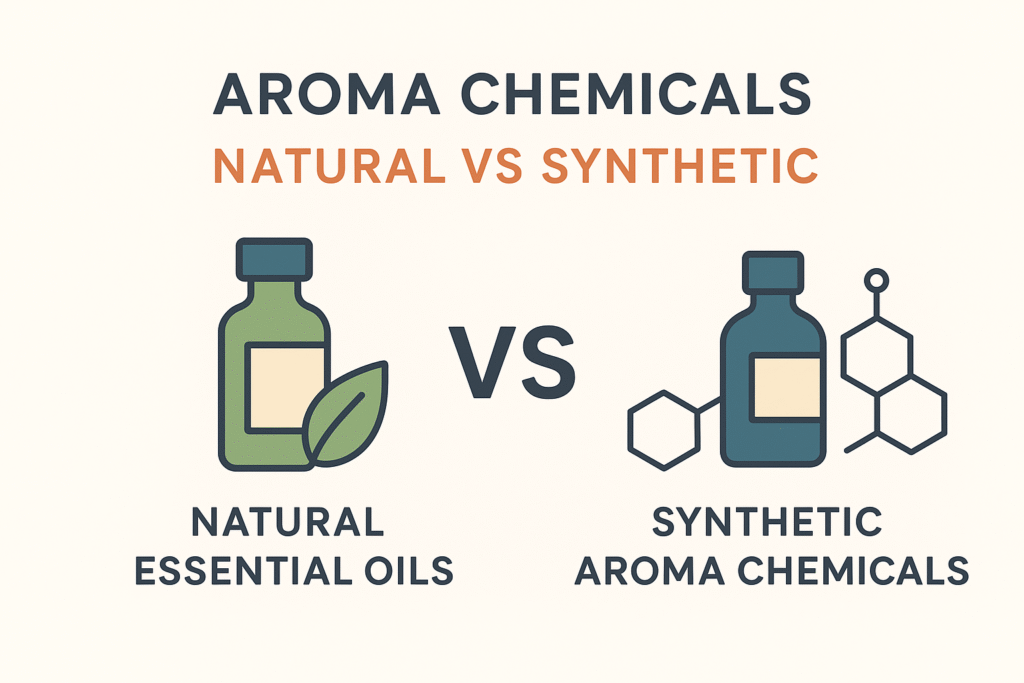Understanding Aroma Chemicals in the Fragrance and Flavor Industry
What Are Aroma Chemicals?
Aroma chemicals are the building blocks of fragrances, present in both natural and synthetic forms. While the word “chemical” often carries a negative connotation, it is important to recognize that everything around us — from our bodies to the food we eat — consists of chemicals. Aroma chemicals are no exception, and they are essential for crafting the scents and flavors that consumers enjoy daily.
In the fragrance and flavor industry, aroma chemicals provide the foundation for perfumes, colognes, candles, personal care products, and even flavored foods and beverages. They define the sensory profile of a product and allow manufacturers to achieve consistency, complexity, and consumer appeal.
Natural Essential Oils as Sources of Aroma Chemicals
Extraction Methods
Natural aroma chemicals are primarily derived from essential oils, which are concentrated volatile compounds extracted from plants. Common techniques include steam distillation, cold pressing, and solvent extraction.
Environmental Factors Influencing Aroma
The aroma profile of essential oils is highly variable and influenced by:
- Soil quality
- Sunlight exposure
- Water availability
- Seasonal and geographic conditions
For example, lavender grown in France may have a slightly different aroma profile than lavender grown in Bulgaria, even though both produce essential oils rich in Linalool.
Benefits and Challenges of Natural Oils
- Advantages: Complex scent profiles, consumer preference for “natural” labels, strong marketing appeal.
- Disadvantages: Inconsistent quality across batches, potential presence of toxic compounds, limited supply depending on harvest conditions.
Synthetic Aroma Chemicals in Fragrance Development
Sources of Synthetic Compounds
Synthetic aroma chemicals can be created through two main pathways:
- Chemically modified natural extracts: Altering natural compounds to enhance or stabilize them.
- Petrochemical derivatives: Utilizing fractions from crude oil to synthesize fragrance ingredients.
Advantages of Synthetic Aroma Chemicals
- Consistent quality and stable supply
- Ability to replicate or enhance natural aromas
- Removal of harmful or undesirable components present in natural oils
- Cost-effectiveness and scalability
Limitations of Synthetic Compounds
- May lack the nuanced complexity of natural oils
- Dependence on non-renewable resources
- Negative perception among consumers who prefer “natural” ingredients
Comparing Natural vs Synthetic Aroma Chemicals
Key Differences
- Coherencia: Synthetic chemicals remain uniform, while natural oils can vary widely.
- Safety: Some natural oils contain allergens or toxins, whereas synthetic alternatives can be purified.
- Cost and Sustainability: Natural oils are limited by agricultural cycles, while synthetics can be mass-produced.
- Percepción del consumidor: Natural oils often carry a higher marketing value, while synthetics provide reliability.
Case Examples
- Linalool: Found in lavender essential oil. Natural Linalool may vary due to growing conditions, while synthetic Linalool ensures consistent aroma quality.
- D-limonene: Found in citrus oils. Natural D-limonene can oxidize and irritate the skin, whereas synthetic versions are more stable and safer for use in cosmetics.
Applications in the Fragrance and Flavor Industry
Aroma chemicals are not limited to fine perfumery. Their applications extend into:
- Personal care products: Soaps, shampoos, lotions
- Home care: Candles, air fresheners, cleaning agents
- Food and beverages: Flavor compounds in sweets, snacks, and drinks
- Pharmaceuticals: Masking unpleasant tastes or enhancing consumer acceptance
This wide range of uses highlights the importance of both natural and synthetic aroma chemicals in delivering consistent, safe, and enjoyable sensory experiences.
The Future of Aroma Chemicals
Blending Natural and Synthetic
The industry trend is moving toward hybrid formulations, where natural essential oils are paired with synthetic aroma chemicals. This approach balances complexity with stability and cost efficiency, creating unique fragrance identities.
Safety and Sustainability Innovations
- Removing harmful substances from natural oils through advanced purification.
- Exploring renewable sources for synthetics, such as bio-based feedstocks.
- Educating consumers to shift perception from “natural vs synthetic” to “safe and effective.”
Customization and Innovation
Brands are increasingly demanding custom aroma solutions to differentiate themselves in competitive markets. By combining natural and synthetic aroma chemicals, companies can create signature fragrances that align with brand identity, cultural preferences, and emerging trends.
FAQs on Aroma Chemicals
- What are the differences between natural essential oils and synthetic aroma chemicals?
Natural oils are complex but inconsistent, while synthetics are stable and predictable. - How do environmental factors influence the aroma profile of essential oils?
Growing conditions such as soil, sunlight, and water affect chemical composition and scent. - What methods are used to extract aroma chemicals from essential oils?
Common methods include steam distillation, cold pressing, and solvent extraction. - Are synthetic aroma chemicals safe to use in fragrances and flavors?
Yes, when regulated and tested. In some cases, synthetics are safer than natural oils because they eliminate harmful compounds.
Conclusión
Aroma chemicals — whether natural or synthetic — are at the heart of the fragrance and flavor industry. Natural essential oils bring complexity and storytelling potential, while synthetic aroma chemicals ensure consistency, safety, and scalability. Together, they enable brands to innovate, create memorable experiences, and meet evolving consumer expectations.
As the industry continues to evolve, the future lies in leveraging both natural and synthetic components to design fragrances and flavors that are not only creative but also safe, sustainable, and truly distinctive.
